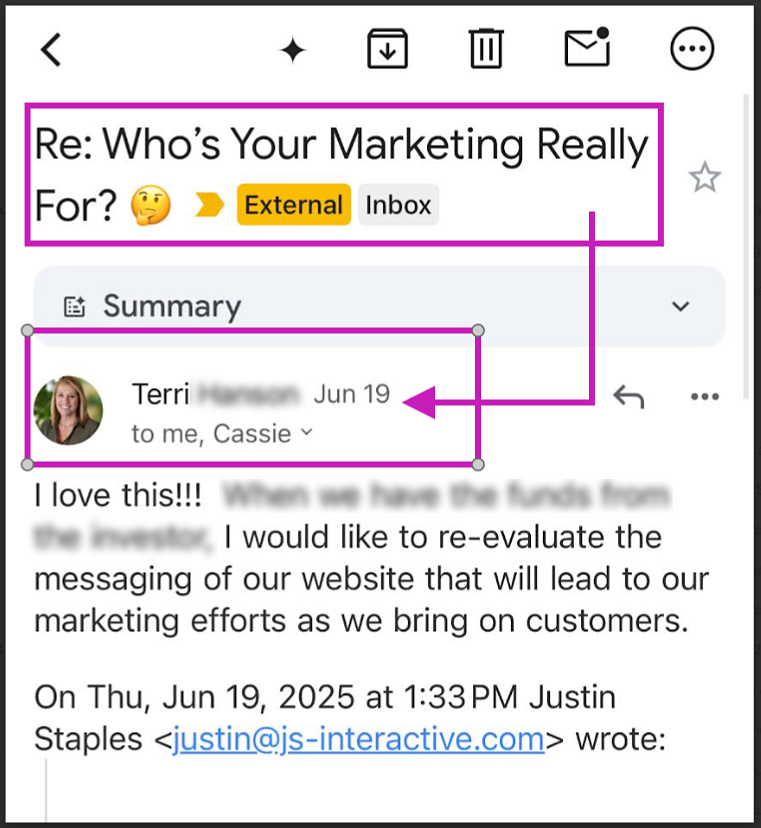Upskilling in the Age of AI: How to Reinvest Your Time for Real Growth

You finally carved out a few hours to get ahead. Draft that blog post, outline a campaign, or catch up on emails.
You open ChatGPT and drop in a prompt, and within minutes, you’ve got a first draft. It’s not bad. A little editing, and it’s usable. Just one less thing on your plate.
But then?
You just fill that freed-up time with more of the same.
Another task.
Another post.
Another sprint to inbox zero.
We’re seeing this everywhere: AI saves time, but most people are just using it to do more, not better.
While nearly 40% of small businesses utilize AI, most fail to leverage the time savings to grow or adjust their strategy. They’re just moving faster on the same hamster wheel.
This blog is for the ones testing the tools but asking, “Is this actually helping?”
We’ll explain how to use AI effectively without getting stuck in the cycle and how to turn saved hours into smarter decisions, stronger marketing, and sustainable growth.
The AI Time Paradox: More Hours, Same Workload
AI has delivered on one of its biggest promises: it’s saving people time. Tasks that used to take hours, like writing, researching, and organizing, can now be completed in minutes.
But here’s the catch: the time we’re getting back isn’t always being used in ways that matter.
AI Is Delivering Big Time Savings
AI tools are helping small businesses complete everyday marketing tasks faster—things like writing blog posts, summarizing research, and organizing content ideas. For many teams, that means saving hours each week.
We’ve seen it firsthand.
We tested tools like Manus, SearchAtlas, BrandWell, Jasper, and others to streamline content and research workflows.
In some cases, we cut production time in half. However, early on, we encountered something unexpected: some tools introduced more complexity than clarity. They didn’t reduce the workload—they just reshaped it.
The turning point came when we stopped trying to use AI everywhere and started applying it where it solved a specific problem. That shift made all the difference.
And we’re not alone.
A 2024 study from Atlassian found that advanced AI users save up to 105 minutes per day. That’s nearly a full workweek every month. What set them apart wasn’t just how often they used AI, but how purposefully they used it.
So yes, AI can absolutely save time.
But that’s only the starting line. What you do with that time is what matters next.
Only 1 in 5 Reinvest That Time Into Growth
According to a 2025 report by Search Engine Land, 93% of marketers say AI saves them time each week. But only 19% reinvest that time into professional development.
The rest? They use it to do more. More tasks. More content. More noise.
We’ve fallen into that trap—saving hours on production but filling them with low-impact deliverables. It felt productive. But it wasn’t progress.
That’s the difference between busy work and meaningful work:
- Busy work fills the calendar.
- Productive work moves the business forward.
Eventually, we had to stop and ask, “Are we growing—or just staying busy?”
That question led us to shift our focus. We started redirecting saved time into strategy, messaging, and systems that actually drive results.
Because more output doesn’t fix broken workflows. And more content isn’t a substitute for clarity.
AI’s value isn’t in how much more you can do. It’s in freeing you up to do what actually matters.
The Upskilling Imperative: Your Time Is Valuable — Use It Wisely
Saving time is only half the win. The other half is what you do with it.
AI can feel like a lifeline for small business owners and lean teams, especially when you’re juggling marketing, operations, and everything in between.
The more these tools remove from your plate, the more critical your judgment, creativity, and leadership become.
AI can:
- Draft the blog
- Suggest the headline
- Summarize research
But it can’t:
- Tell you what your audience actually cares about
- Set priorities
- Define your brand’s point of view
That part still comes down to you.
The businesses that are pulling ahead aren’t just using AI to go faster. They are using it to go deeper. They are shifting from task execution to capability building.
Not because they had to, but because they saw the opportunity.
AI Changes the Job Description and the Skills That Matter
You don’t need to be an AI expert. But you do need to be ready for a different kind of role.
As AI takes over execution, what’s left is the work only you can do: prioritizing, guiding strategy, and understanding your audience.
According to The Times, CEOs now say skill gaps are the top barrier to AI success. Those gaps aren’t technical. They show up in areas like analytical reasoning, creativity, empathy, and judgment.
That’s why the most successful leaders aren’t chasing every tool. They’re rethinking how they lead.
What Upskilling Really Looks Like in the Age of AI
Upskilling doesn’t mean learning to code. And it doesn’t mean chasing every new platform that launches next quarter.
It means developing the skills that AI can’t replace, but can amplify.
The problem? Most businesses miss that distinction. According to the Marketing AI Institute, 67% of marketers cite a lack of training as the biggest barrier to AI adoption, yet only about one in four say their organization offers any training.
That disconnect leaves teams unsure how to adapt. It shows up in scattered priorities, misused tools, and content that blends in instead of standing out.
So what does upskilling actually look like?
It looks like:
- Asking smarter questions to guide AI output
- Knowing when to trust AI, and, more importantly, when to override it
- Strengthening your ability to lead, prioritize, and adapt
- Bringing creative and strategic thinking into your process
These skills provide lasting value to your work, regardless of how tools change. If AI saves you time, upskilling helps transform that time into long-term benefits. However, knowing you need to grow is different from knowing where to begin. That’s where intention comes into play.
5 Actionable Ways to Reinvest Time Saved With AI
Knowing there’s a gap is one thing. Knowing how to close it is another.
If you’ve already started saving time with AI, the next step isn’t to do more of the same. It’s to be more intentional about how that time gets used.
This isn’t about adding more to your to-do list. It’s about taking the hours AI gives you back and putting them to work in ways that actually move your business forward.
Here are five simple, practical ways to do precisely that.
1. Block Out Time to Think, Not Just Do
When AI clears an hour from your calendar, the natural instinct is to fill it. A few emails. A couple of quick revisions. Another piece of content.
But what if you used that time to step back and actually think strategically?
Set aside 30 to 60 minutes each week to zoom out. Not to catch up on tasks, but to ask bigger questions:
- Is our messaging still aligned?
- Are we putting effort behind the right things?
- What’s missing from our marketing that AI can’t answer?
This isn’t downtime. It’s decision time.
Put it on your calendar like a client meeting. Treat it like real work, because it is. If you don’t protect space to think critically, that time will disappear, just like every other “free hour” you hoped to use differently.
Reinvesting time doesn’t always mean learning a new tool. Sometimes, it just means giving yourself enough room to think clearly and lead intentionally.
2. Use AI to Test Ideas Faster, Not Just Produce Content Faster
It’s easy to default to using AI for output. Need a blog post? A caption? A headline? Done.
But the real value isn’t just in producing faster. It’s in testing smarter.
Use AI to explore creative directions before you commit. Treat the tool like a creative partner during the early stages, not a factory for finished work.
Instead of rushing content to completion, use it to compare options quickly:
- Ad headlines
- Social post variations
- Email intros or subject lines
- CTAs for landing pages
- Blog angles or lead-ins

The goal isn’t to let AI do the thinking. It’s to let it handle the grunt work, so you can spend more time shaping what actually resonates.
3. Ask Better Questions Instead of Chasing More Tools
The pressure to keep up with AI can make every new tool feel urgent. But adding more software doesn’t always solve the problem. Sometimes, it just makes the process messier.
Before you commit to another platform, ask yourself:
- What’s the actual bottleneck we’re trying to solve?
- Is the team struggling because of capacity, clarity, or both?
- Will this tool streamline our process, or just layer more steps on top?
- Do we have a plan for how this tool fits into our existing workflow and priorities?
- If we adopt this, who owns it, and how will we define success?
These are the kinds of questions that prevent tool overload and guide better decisions. AI can do a lot, but it works best when introduced with a purpose, not panic. Choosing the right tools intentionally is how you build lasting momentum.
4. Create Once, Then Scale Smartly
In Salesforce’s 2025 SMB Trends Report, content generation was ranked as the second most valuable use case for AI, especially among businesses with small or overstretched marketing teams.
However, producing content faster is only part of the story. The smarter move is to stretch your best ideas further.
That is exactly how we approach it. A single blog post often becomes:
- An email newsletter
- A LinkedIn newsletter
- A series of image-based social media posts
- And, more recently, short-form video content
AI helps us repackage and adapt content without starting from scratch. It is not about doing more. It is about getting more out of the work you have already done.
Recently, we turned a blog post into an email newsletter. Within a few hours, a client replied. She said it resonated and made her realize it was time to revisit her brand messaging.

This is where real efficiency lives. Not in doing more, but in making more of what you already have.
5. Spend Saved Time on Work That AI Can’t Do
AI is great at saving time. But the most meaningful use of that time isn’t more output. It’s deeper work that still depends on human experience, empathy, and nuance.
Use the margin AI gives you to focus on things like:
- Client conversations that uncover new needs
- Strategy sessions that align your team
- Audits of your messaging, positioning, or customer journey
- Creative development that goes beyond “what’s trending”
These are the moments that grow a business. And while AI can help clear the path, those next steps still require you.
Don’t Just Work Smarter—Grow Smarter
AI gives you time back. What you do with it is what sets you apart. Upskilling isn’t optional. It’s how marketers stay relevant and businesses stay resilient.
At JS Interactive, we believe in a better balance: AI efficiency paired with human growth. That’s how you build long-term, sustainable success.
Want help figuring out what’s worth your time—and what’s just noise? Contact us today.